View in other NatureServe Network Field Guides
NatureServe
Montana
Utah
Wyoming
Idaho
Wisconsin
British Columbia
South Carolina
Yukon
California
New York
Blunt-leaved Pondweed - Potamogeton obtusifolius
State Rank Reason (see State Rank above)
Known from over a dozen occurrences in northwest Montana. Several contain moderate to large-size populations and occur in valley and foothill locations in a variety of federal, state, and private ownerships. A few populations are on lands managed specifically for their conservation value. Some populations are vulnerable to impacts associated with development, recreation and increased sediment and nutrient loads.
General Description
PLANTS: An aquatic perennial with slender, submergent, or floating stems that are up to 100 cm long and slightly flattened. Plants produce abundant free-floating turions (overwintering buds) that are terminal on the stems. Rhizomes are absent. Sources: Giblin et al. [eds.] 2018); Lesica et al. 2012; Haynes and Hellquist in Flora of North America (FNA) 2000.
LEAVES: Submersed leaves are linear, 3-10 cm long, and 2-4 mm wide, each with a small,round, yellow green to gold gland on either side at the base. There is a white-membranous leaf stipule that surrounds the stem above the point where the leaf diverges. Herbage is glabrous. Leaves have 2 veins plus a midvein. Floating leaves are absent. Sources: Giblin et al. [eds.] 2018); Lesica et al. 2012; Haynes and Hellquist in FNA 2000.
INFLORESCENCE: The minute, inconspicuous flowers are borne in a spike, 8-13 mm long and on a long stalk (peduncle) in the axils of the upper leaves. Source: Lesica et al. 2012; Haynes and Hellquist in FNA 2000.
The specific epithet obtusifolius is a combination of the Latin words obtusus and folium meaning blunt and leaf respectively (Merriam-Webster 2019). Potamogeton is derived from the Greek words potamos meaning river and geiton meaning neighbor (Merriam-Webster 2019).
Phenology
Plants flower and fruit from summer to fall (Haynes and Hellquist in FNA 2000). Mature fruit develop beginning in August (Camp et al. 2011).
Diagnostic Characteristics
Montana has 21
Potamogeton species. They are all aquatic perennials with submergent leaves, but some species also have floating leaves, often of a different shape. All species have small, sessile flowers arranged in a cylindrical spike with a long stem (peduncle) that grows from the axil of a leaf.
Many floras have split
Potamogeton into two genera based on molecular evidence and the following morphology (Haynes and Hellquist
FNA 2000; Giblin et al. [eds.] 2018):
Potamogeton
*Floating leaves present or absent.
*Submersed leaves: Stipule is free from the leaf blade, or if attached the fused (adnate) portion is 5 mm or less and no more than half the stipule’s length.
*Submersed leaf blades are translucent, not channeled, and are flat.
*Peduncle of the inflorescence is stiff and can project above the water.
*18 Montana species.
Stuckenia
*Floating leaves never present.
*Submersed leaves: At least two-thirds of the stipule is adnate to the base of the leaf, usually for more than 10 mm and it forms a sheath around the stem.
*Submersed leaf blades are opaque, channeled, and are turgid.
*Peduncle of the inflorescence is flexible and does not project above the water (is submersed).
*3 Montana species.
Blunt-leaved Pondweed-Potamogeton obtusifolius, native, SOC
*Stems: Slightly compressed and branched with globose glands at the nodes.
*Floating Leaves: absent.
*Submersed Leaves: Linear, 3-8 cm long and 2-4 mm wide, with a blunt tip, and attached directly to the stem at the base of the stipule.
*Stipules: 1-2 cm long, membranous, and sheathing.
*Spikes: About 1 cm long.
*Tepals: Green and about 1 mm long
*Achenes: Barely keeled and 3-3.5 mm long including the erect beak.
Curly-leaf Pondweed-Potamogeton crispus, exotic, noxious
*Stems: Slightly flattened and mostly straight.
*Floating Leaves: absent (though stems break off and float).
*Submersed Leaves: Mature leaf blades clasp the stem, are linear to oblong with wavy margins (like a lasagna noodle) and minute teeth. Leaves lack a stem (petiole).
Leafy Pondweed-Potamogeton foliosus, native
* Montana plants are variety foliosus.
*Stems: Slightly compressed and branched and lacking globose glands at the nodes.
*Floating Leaves: absent.
*Submersed Leaves: Linear, 1-4 cm long and about 1 mm wide, and attached directly to the stem at the base of the stipule.
*Stipules: 5-10 mm long and sheathing but frying above.
*Spikes: 1-6 mm long and capitate.
*Tepals: Green and =1 mm long.
*Achenes: 1.5-2 mm long. Abaxial keel is wing-like and beak is erect, 0.2-0.6 mm.
*A combination of linear leaves and fruits with an undulating, wing-like abaxial keel (not lateral keel) are most likely this species.
Slender Pondweed-Potamogeton filiformis, native
*Stems: Cylindrical (terete) and branched. Less branched above.
*Floating Leaves: absent.
*Submersed Leaves: Filiform, 1-8 cm long and 1-2 mm wide, and attached directly to the stipule (not the stem). Leaf tip acute to acuminate or blunt or asymmetrically notched. Leaf tapers only within the last 1 mm of the tip.
*Stipules: Lower stipule 5-15 mm long and sheathing. Tip of stipule extends as a ligule up to 20 mm beyond their junction with the base of the leaf blade.
*Spikes: 1-5 cm long with distinct whorls of flowers.
*Tepals: Brownish and 1-2 mm long.
*Achenes: 2-3 mm long and obscurely keeled with a minute beak.
*Rhizomes not tuberous.
*Often confused with Potamogeton vaginatus or Potamogeton pectinatus.
Sheathed Pondweed-Potamogeton vaginatus, native
*Stems: Cylindrical (terete) and branched.
*Floating Leaves: absent.
*Submersed Leaves: linear, 2-10 cm long and 1-2 mm wide, and attached directly to the stipule (not the stem).
*Stipules: Lower stipule 1-5 mm long and sheathing, brown, and swollen at the base. Tip of stipule extend as a ligule, 0-2mm beyond their junction with the base of the leaf blade.
*Spikes: 1-5 cm long with well-separated whorls of flowers.
*Tepals: Brownish-green and 1-2 mm long.
*Achenes: 2-3(-3.8) mm long and obscurely keeled and beaked.
*Often confused with Potamogeton filiformis or Potamogeton pectinatus.
Sago Pondweed-Potamogeton pectinatus, native
*Stems: Cylindrical (terete)and branched. Highly branches, especially above.
*Floating Leaves: absent.
*Submersed Leaves: Filiform, 1-10 cm long and <1 mm wide, and attached directly to the stipule (not the stem). Leaf tip acute to acuminate, apiculate, or mucronate on young plants. Leaf tapers within the last 3 mm of the tip.
*Stipules: Lower stipules 1.5-30 mm long, tightly sheathing, but not swollen. Tip of stipule extends as a ligule up to 20 mm beyond their junction with the base of the leaf blade.
*Spikes: 1-5 cm long with distinct whorls of flowers.
*Tepals: Brownish-green and 1-1.5 mm long.
*Achenes: 3-4 mm long and obscurely keeled with a slender, curved beak.
*Rhizomes tuberous.
*Often confused with Potamogeton filiformis or Potamogeton vaginata.Species Range
Montana Range
Range Descriptions
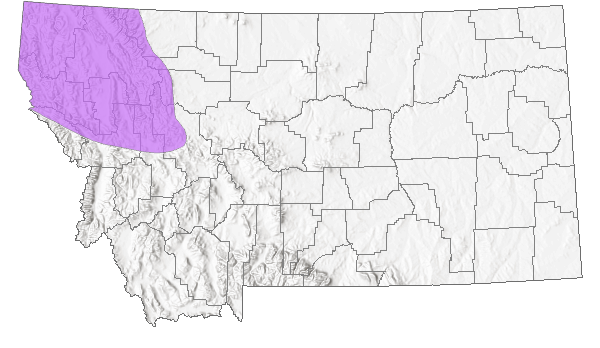
 Native
Native
Range Comments
Blunt-leaved Pondweed is a circumboreal species that in North America is found south to Washington, Wyoming, and New York (Lesica et al. 2012).
Observations in Montana Natural Heritage Program Database
Number of Observations: 30
(Click on the following maps and charts to see full sized version)
Map Help and Descriptions
Relative Density
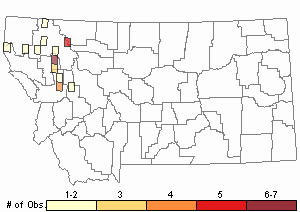
Recency

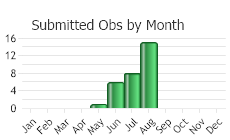
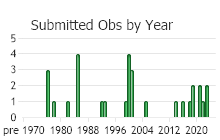
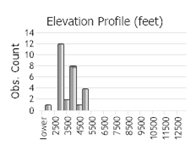 (Observations spanning multiple months or years are excluded from time charts)
(Observations spanning multiple months or years are excluded from time charts)
Habitat
Blunt-leaved Pondweed prefers the shallow water of lakes, ponds, and sloughs in the valleys, foothills, and montane zones of Montana (Lesica et al. 2012). It may also grow in slow-flowing waters of small streams (Camp et al. 2011).
Ecological Systems Associated with this Species
Ecology
ASSOCIATED SPECIES
Blunt-leaved Pondweed can often be found with other pondweeds (Potamogeton spp.) as well as Common Bladderwort (Utricularia vulgaris), Shortspike Watermilfoil (Myriophyllum sibiricum), Coon’s Tail (Ceratophyllum demersum), and Canadian Waterweed (Elodea Canadensis) (Camp et al. 2011).
VULNERABILITY TO EXTIRPATION
Long-term habitat quality changes in northwestern Germany have led to the decrease in most native Potamogeton species and the extirpation of Potamogeton obtusifolius (Wiegleb et al. 1991). Blunt-leaved Pondweed was one of three Potamogeton species that have disappeared from this area. All three species were extremely rare to begin with and local extinction could have been caused by fluctuations in small populations compounded by human alteration. These fluctuations make Blunt-leaved Pondweed populations vulnerable to disturbance and habitat loss.
Dr. J.E. Dandy from the Botany branch of the British Museum is quoted as saying “…these potamogetons behave as annuals and are often on the move, arriving suddenly in a locality and sometimes disappearing just as suddenly” (Booth et al. 1966).
NUTRIENT LEVELS
While members of the genus can be found in a wide range of water types, each species of Potamogeton has specific preferences for both chemical and physical conditions of their habitat (Wiegleb et al. 1991). Blunt-leaved Pondweed prefers systems with nutrient rich water layers and more specifically, mesotrophic waters with phosphate concentrations between 0.5 and 1 µmol1-1 (Smolders et al. 2001). They also thrive in slightly calcareous waters with pH ranging between 7 and 8 (Smolders et al. 2001).
They may have specific nutrient requirements of their habitat, but Potamogeton species play an important part in the balance of these ecosystems because of their contribution to primary production, nutrient cycling, exchange of gaseous substances, sediment fixation, and habitat diversification for animals and periphyton (Wiegleb et al. 1991).
HERBIVORY
A study on the relationship between the leaf dry matter content of freshwater macrophytes and herbivore palatability revealed Blunt-leaved Pondweed to be the least consumed by snails for the species studied (Elger et al. 2003). Blunt-leaved Pondweed was one of the species with the highest proportion of dry matter content (Elger et al. 2003). Snail herbivory also plays a part in the distribution of Potamogeton within riverine systems (Wiegleb et al. 1991).
ROOTING DEPTH
A study on the effects of shade and rooting depths for Potamogeton obtusifolius plants growing in the Esthwaite Waters, United Kingdom revealed dramatic effects on plant morphology, reproduction, and photosynthetic rates (Maberly 1993). Plants were collected at rooting depths below surface waters at 0.5 meter (m) and 3.6 m. While leaf surface area increased, leaf dry weight, shoot dry weight, and shoot length all decreased significantly from the 0.5 m to the 3.6 m rooting depths. When taking losses of individuals into account, populations at depths or 3.6 m were not able to contribute enough to reproduction of the next season’s populations to exhibit net growth or even to maintenance current population sizes. This indicates that the deeper populations (rooted at greater than 0.5 meters below the surface water) are maintained by the movement of turions.
ALLELOPATHIC POTENTIAL
Potamogeton species contain terpenoids and alkaloids, both potential allelochemicals (Gao et al. 2017). Allelochemicals are biochemicals released by plants that affect the growth, health, behavior, or population biology of other organisms around them (Gao et al 2017). Terpenoids in the forms of essential oils and monoterpenes strongly inhibit seed germination and plant growth (Fischer et al. 1994). Both terpenoids and alkaloids may cause plants to be bitter tasting or even toxic for herbivores (Harborne 1993).
The allelopathic effects of Potamogeton may be species specific (Gao et al. 2017). Effects were tested of two Potamogeton species on two algae species, Raphidocelis subcapitata and Microcystis aeruginosa. Potamogeton maackianus was found to show stronger inhibition on Microcystis aeruginosa while the inhibitory effects of Potamogeton malaianus were stronger on Raphidocelis subcapitata.
Reproductive Characteristics
FLOWERS
The flowers are arranged in a spike about 1 cm long and consist of conspicuous stamens and an ovary and very small (about 1 mm long), green tepals (Lesica et al. 2012).
FRUIT
The mature fruit of Blunt-leaved Pondweed is a compressed, ovoid achene with a faint keel on the outer edge (Lesica et al. 2012). Each achene is 3-3.5 mm long including the 0.8-1 mm long, erect beak (Lesica et al. 2012). The achenes are sessile along the stem and are olive-green to brown (Haynes and Hellquist in FNA 2000).
LIFE CYCLE
Mature fruit begin developing in August (Camp et al. 2011). Plants die back at the end of the growing season and leave only buds or seeds (Maberly 1993). Turions sink and overwinter in mud until forming new plants the following summer (Lesica et al. 2012).
Stewardship Responsibility
Threats or Limiting Factors
In Montana the major threats identified to Blunt-leaved Pondweed viability are from domestic livestock foraging, habitat conversion/loss/development, and recreation by motor boats (Montana Native Plant Society 2007).
Blunt-leaved Pondweed is threatened by habitat alteration created by recreational use along shorelines and herbicides used to control invasive aquatic species (Camp et al. 2011). Because the parameters that each species of Potagmogeton require to occupy such a limited window, small changes in stream water quality can be detrimental to the survival of any given species including Potamogeton obtusifolius (Wiegleb et al. 1991).
STATE THREAT SCORE REASON
Reported threats to Montana’s populations of Blunt-leaved Pondweed include impacts due to livestock grazing and trampling (MTNHP Threat Assessment 2021). Potential threats due to development are acknowledged, as a population was likely displaced following the construction of a parking lot. Information is needed if current or future impacts due to development are known. Motorboat recreation is also indicated to threaten populations, but information about the scope and severity of this threat is needed to assess its relative risk.
References
- Literature Cited AboveLegend:
 View Online Publication
View Online Publication Hitchcock, C.L. and A. Cronquist. 2018. Flora of the Pacific Northwest: An Illustrated Manual. Second Edition. Giblin, D.E., B.S. Legler, P.F. Zika, and R.G. Olmstead (eds). Seattle, WA: University of Washington Press in Association with Burke Museum of Natural History and Culture. 882 p.
Hitchcock, C.L. and A. Cronquist. 2018. Flora of the Pacific Northwest: An Illustrated Manual. Second Edition. Giblin, D.E., B.S. Legler, P.F. Zika, and R.G. Olmstead (eds). Seattle, WA: University of Washington Press in Association with Burke Museum of Natural History and Culture. 882 p. Lesica, P., M.T. Lavin, and P.F. Stickney. 2012. Manual of Montana Vascular Plants. Fort Worth, TX: BRIT Press. viii + 771 p.
Lesica, P., M.T. Lavin, and P.F. Stickney. 2012. Manual of Montana Vascular Plants. Fort Worth, TX: BRIT Press. viii + 771 p. MTNHP Threat Assessment. 2021. State Threat Score Assignment and Assessment of Reported Threats from 2006 to 2021 for State-listed Vascular Plants. Botany Program, Montana Natural Heritage Program, Helena, Montana.
MTNHP Threat Assessment. 2021. State Threat Score Assignment and Assessment of Reported Threats from 2006 to 2021 for State-listed Vascular Plants. Botany Program, Montana Natural Heritage Program, Helena, Montana.
- Additional ReferencesLegend:
 View Online Publication
View Online Publication
Do you know of a citation we're missing? Aulio, K. and M. Salin. 1982. Enrichment of copper, zinc, manganese, and iron in five species of pondweeds (Potamogeton spp.). Bulletin of Environmental Contamination and Toxicology 29:320-325.
Aulio, K. and M. Salin. 1982. Enrichment of copper, zinc, manganese, and iron in five species of pondweeds (Potamogeton spp.). Bulletin of Environmental Contamination and Toxicology 29:320-325. Danell, K. 1977. Short-term plant successions following the colonization of a northern Swedish lake by the muskrat, Ondatra zibethica. Journal of Applied Ecology 14:933-947.
Danell, K. 1977. Short-term plant successions following the colonization of a northern Swedish lake by the muskrat, Ondatra zibethica. Journal of Applied Ecology 14:933-947. Lesica, P., M.T. Lavin, and P.F. Stickney. 2022. Manual of Montana Vascular Plants, Second Edition. Fort Worth, TX: BRIT Press. viii + 779 p.
Lesica, P., M.T. Lavin, and P.F. Stickney. 2022. Manual of Montana Vascular Plants, Second Edition. Fort Worth, TX: BRIT Press. viii + 779 p. Pip, E. 1987. The ecology of Potamogeton species in central North America. Hydrobiologia 153:203-216.
Pip, E. 1987. The ecology of Potamogeton species in central North America. Hydrobiologia 153:203-216. Toivonen, H. and C. Nybom. 1989. Aquatic vegetation and its recent succession in the waterfowl wetland Koijarvi, S. Finland. Ann. Bot. Fennici 26:1-14.
Toivonen, H. and C. Nybom. 1989. Aquatic vegetation and its recent succession in the waterfowl wetland Koijarvi, S. Finland. Ann. Bot. Fennici 26:1-14. Toivonen, H. and S. Back. 1989. Changes in aquatic vegetation of a small eutrophicated and lowered lake (southern Finland). Ann. Bot. Fennici 26:27-38.
Toivonen, H. and S. Back. 1989. Changes in aquatic vegetation of a small eutrophicated and lowered lake (southern Finland). Ann. Bot. Fennici 26:27-38.
- Web Search Engines for Articles on "Blunt-leaved Pondweed"





